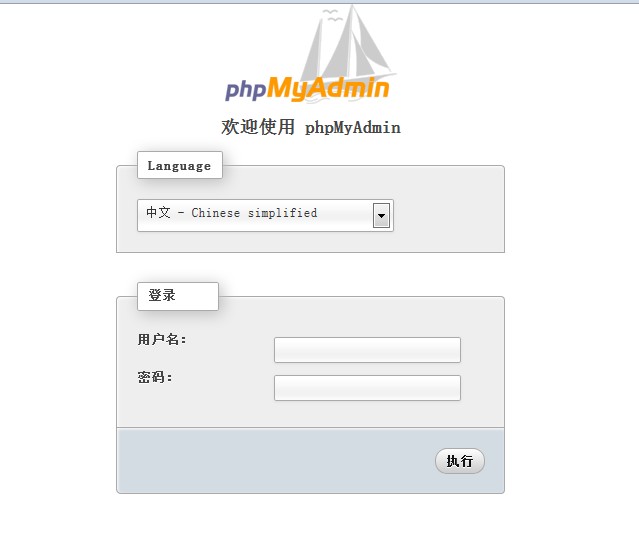CentOS停配置PHP,phpMyAdmin
CentOS下配置PHP,phpMyAdmin
原创文章,转载请注明出处:http://www.aj2ee.com
今天花了点时间在自己的VPS上配置了PHP环境,并配置了phpmyadmin来管理mysql数据库。
之前的写了几篇linux下apache,jdk,tomcat,svn,vsftpd,yum的配置。apache已经与tomcat,svn整合好。
要用phpmyadmin来管理mysql数据库,那就必须配置php环境,我还是用yum来安装php。
我的CentOS yum里的php版本的有两个,一个是5.2的,另一个5.3,我安装了5.3的版本。
在安装php53-mysql(用于php连接mysql数据库) 的时候出现问题了:
我MySQL安装是从mysql网站上下载的两个rpm包安装的:
MySQL-server-community-5.1.61-1.rhel5.i386.rpm
MySQL-client-community-5.1.61-1.rhel5.i386.rpm
当用yum安装php53-mysql时总是报如下错误:
Error: mysql conflicts with MySQL-server-community mysql与MySQL-server-community发生冲突。
我也试过用上面提示的 --skip-broken 参数来跳过,但还是无效。
后来在一个英文网站上找到解决方案:
首选要下载MySQL的一个rpm包:MySQL-shared-compat-5.1.63-1.rhel5.i386.rpm
然后按照下面的方法安装:
执行完这些后,再用yum安装php53-mysql
[root@MyVPS certs]# yum install php53-mysql
这回就能安装成功。
测试下php是否安装成功:将下面的代码保存成info.php放入网站根目录
输入http://localhost/info.php 显示如下:

下面从网上下载phpmyadmin phpMyAdmin-3.5.1-all-languages.tar.gz
把这个压缩文件上传到VPS上,解压,并放到网站的根目录下:
重启完httpd服务后,输入网址:http://localhost/phpmyadmin 显示如下:

回顾下apache,jdk,tomcat,svn,vsftpd,yum的配置:
JDK1.6+Tomcat6
MySQL5.1
Apache2.2+svn1.6
Apache2.2+2Tomcat6
vsftp2
YUM

Hot AI Tools

Undresser.AI Undress
AI-powered app for creating realistic nude photos

AI Clothes Remover
Online AI tool for removing clothes from photos.

Undress AI Tool
Undress images for free

Clothoff.io
AI clothes remover

Video Face Swap
Swap faces in any video effortlessly with our completely free AI face swap tool!

Hot Article

Hot Tools

Notepad++7.3.1
Easy-to-use and free code editor

SublimeText3 Chinese version
Chinese version, very easy to use

Zend Studio 13.0.1
Powerful PHP integrated development environment

Dreamweaver CS6
Visual web development tools

SublimeText3 Mac version
God-level code editing software (SublimeText3)

Hot Topics
 1386
1386
 52
52
 How to open phpmyadmin
Apr 10, 2025 pm 10:51 PM
How to open phpmyadmin
Apr 10, 2025 pm 10:51 PM
You can open phpMyAdmin through the following steps: 1. Log in to the website control panel; 2. Find and click the phpMyAdmin icon; 3. Enter MySQL credentials; 4. Click "Login".
 MySQL: An Introduction to the World's Most Popular Database
Apr 12, 2025 am 12:18 AM
MySQL: An Introduction to the World's Most Popular Database
Apr 12, 2025 am 12:18 AM
MySQL is an open source relational database management system, mainly used to store and retrieve data quickly and reliably. Its working principle includes client requests, query resolution, execution of queries and return results. Examples of usage include creating tables, inserting and querying data, and advanced features such as JOIN operations. Common errors involve SQL syntax, data types, and permissions, and optimization suggestions include the use of indexes, optimized queries, and partitioning of tables.
 How to use single threaded redis
Apr 10, 2025 pm 07:12 PM
How to use single threaded redis
Apr 10, 2025 pm 07:12 PM
Redis uses a single threaded architecture to provide high performance, simplicity, and consistency. It utilizes I/O multiplexing, event loops, non-blocking I/O, and shared memory to improve concurrency, but with limitations of concurrency limitations, single point of failure, and unsuitable for write-intensive workloads.
 Why Use MySQL? Benefits and Advantages
Apr 12, 2025 am 12:17 AM
Why Use MySQL? Benefits and Advantages
Apr 12, 2025 am 12:17 AM
MySQL is chosen for its performance, reliability, ease of use, and community support. 1.MySQL provides efficient data storage and retrieval functions, supporting multiple data types and advanced query operations. 2. Adopt client-server architecture and multiple storage engines to support transaction and query optimization. 3. Easy to use, supports a variety of operating systems and programming languages. 4. Have strong community support and provide rich resources and solutions.
 MySQL's Place: Databases and Programming
Apr 13, 2025 am 12:18 AM
MySQL's Place: Databases and Programming
Apr 13, 2025 am 12:18 AM
MySQL's position in databases and programming is very important. It is an open source relational database management system that is widely used in various application scenarios. 1) MySQL provides efficient data storage, organization and retrieval functions, supporting Web, mobile and enterprise-level systems. 2) It uses a client-server architecture, supports multiple storage engines and index optimization. 3) Basic usages include creating tables and inserting data, and advanced usages involve multi-table JOINs and complex queries. 4) Frequently asked questions such as SQL syntax errors and performance issues can be debugged through the EXPLAIN command and slow query log. 5) Performance optimization methods include rational use of indexes, optimized query and use of caches. Best practices include using transactions and PreparedStatemen
 phpmyadmin creates data table
Apr 10, 2025 pm 11:00 PM
phpmyadmin creates data table
Apr 10, 2025 pm 11:00 PM
To create a data table using phpMyAdmin, the following steps are essential: Connect to the database and click the New tab. Name the table and select the storage engine (InnoDB recommended). Add column details by clicking the Add Column button, including column name, data type, whether to allow null values, and other properties. Select one or more columns as primary keys. Click the Save button to create tables and columns.
 Monitor Redis Droplet with Redis Exporter Service
Apr 10, 2025 pm 01:36 PM
Monitor Redis Droplet with Redis Exporter Service
Apr 10, 2025 pm 01:36 PM
Effective monitoring of Redis databases is critical to maintaining optimal performance, identifying potential bottlenecks, and ensuring overall system reliability. Redis Exporter Service is a powerful utility designed to monitor Redis databases using Prometheus. This tutorial will guide you through the complete setup and configuration of Redis Exporter Service, ensuring you seamlessly build monitoring solutions. By studying this tutorial, you will achieve fully operational monitoring settings
 How to view sql database error
Apr 10, 2025 pm 12:09 PM
How to view sql database error
Apr 10, 2025 pm 12:09 PM
The methods for viewing SQL database errors are: 1. View error messages directly; 2. Use SHOW ERRORS and SHOW WARNINGS commands; 3. Access the error log; 4. Use error codes to find the cause of the error; 5. Check the database connection and query syntax; 6. Use debugging tools.




